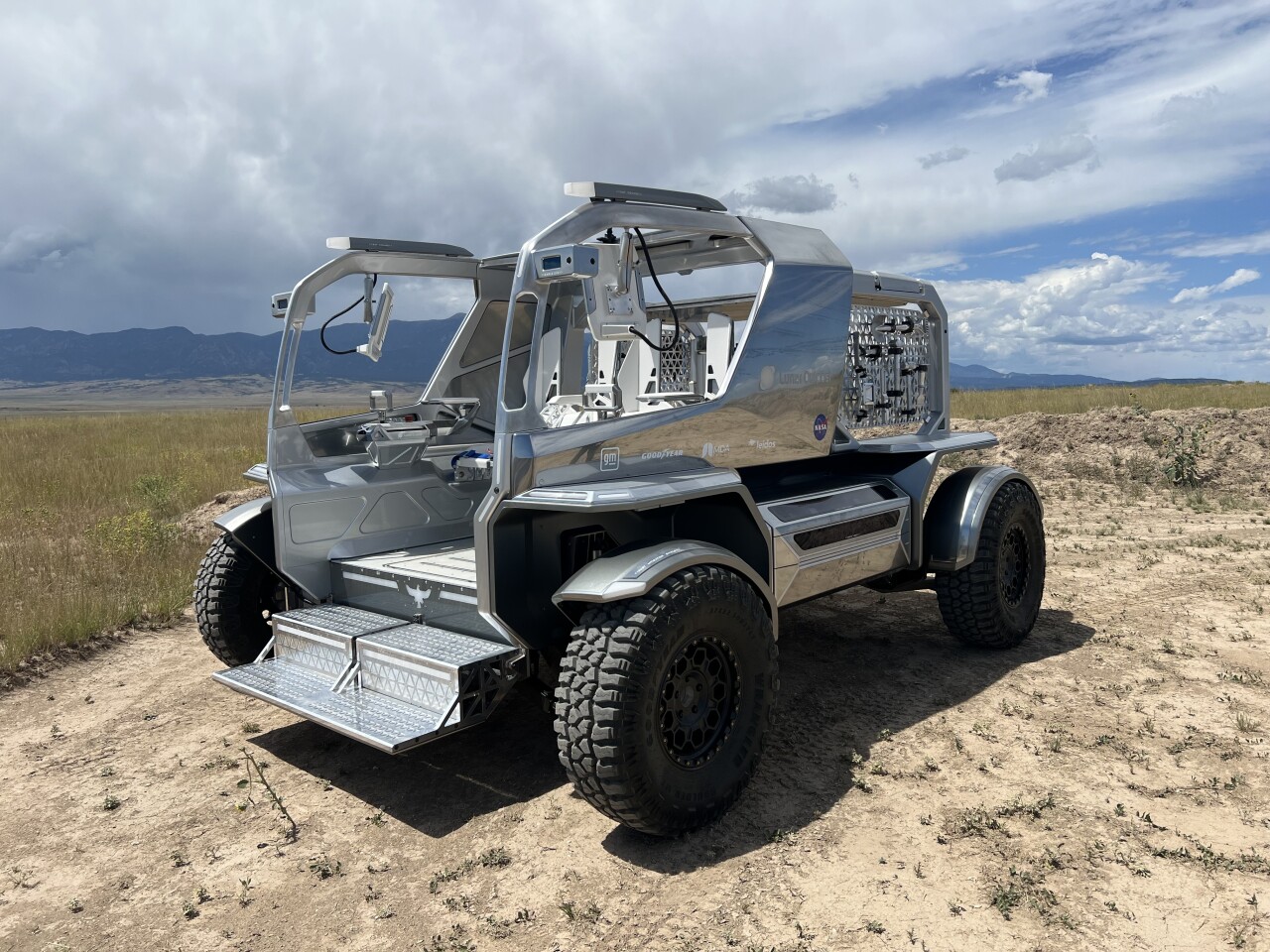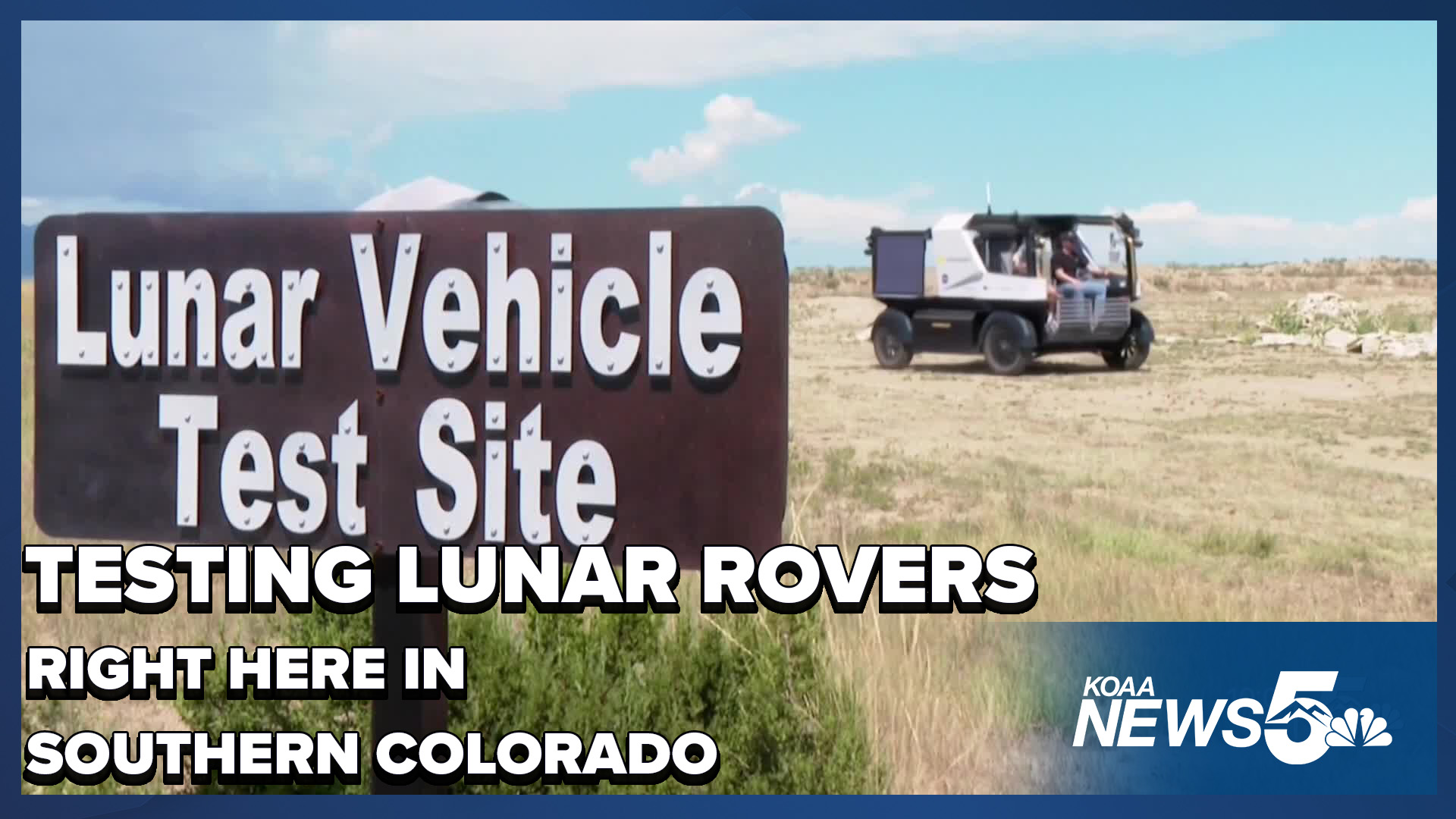RYE, Colo. — Perhaps the most striking feature of the Colorado-based Lunar Outposts’ moon rover–of which there are many–are its metal mesh tires. They appear to be almost like chain mail on a 36-inch wheel.
“It really is a cool material. It's reliable. It absorbs impacts well,” said Justin Cyrus, CEO and founder of Lunar Outpost. “It gives you great traction. So for our vehicle, the Lunar Terrain Vehicle ‘Eagle,’ this is the right tire technology.”
The metal alloy was designed by Lunar Outpost’s partners on the project at Goodyear Tire Company. Cyrus wouldn’t reveal the composition of the alloy, but it’s one of many aspects to be specifically designed and developed for this massive undertaking.
In the US push to return astronauts to the moon’s surface–and eventually Mars–commercial companies like Lunar Outpost have been enlisted to develop new Lunar Terrain Vehicles (LTV) for astronaut transportation. Their rover can also be remotely controlled from the company’s Arvada mission control center.

The Lunar Outpost LTV, named The Eagle, has taken some notes from off-roading vehicles in its design. Tools on the side, like shovels and traction boards, are easily accessible on panels inspired by off-roading molle panels.
Through various tests, including with astronauts, the company has evolved its designs that include T-bar driving handles, wide berth seats so astronauts in their bulky suits can sit comfortably (or as comfortably as astronauts can be), and rooftop solar panels that can deploy for charging.
Lunar Outpost showcased two versions of the Eagle for members of the press, including the Raven for autonomous testing demonstrations and the Falcon, which is a larger, sleeker-looking model that’s more likely to be the shape and size of the eventual Eagle LTV on the lunar surface.
Three Competing Companies and NASA Selection Process
Lunar Outpost is one of three companies that made it out of phase one for NASA’s selection process for a new LTV. The other two are Texas-based Intuitive Machines and California-based Venturi Astrolab.
This is all part of NASA’s Artemis campaign to send humans to the moon, preparing them for Mars exploration. It’s an intensive process for an intensive goal.
From NASA’s page on the moon mobility for Artemis missions: “The LTV will be able to handle the extreme conditions at the Moon’s South Pole and will feature advanced technologies for power management, autonomous driving, and state of the art communications and navigation systems. Crews will use the LTV to explore, transport scientific equipment, and collect samples of the lunar surface, much farther than they could on foot, enabling increased science returns.”

During a two-day event for a handful of press at Lunar Outpost’s Arvada Mission Control and Lunar Vehicle Testing Site, company leadership highlighted how their LTV has achieved all of NASA’ stated requirements and then some.
“Where we are right now in the story–we all finished phase one. There were three companies that were competitive, that were selected from a pool of bidders over a year ago,” said Michael Moreno, VP of Strategy for Lunar Outpost. “Only one company, maybe two, is going to win phase two.”
The expected NASA announcement on the winning design could come by November. NASA’s contract could have a combined maximum potential value of $4.6 billion for all awards.
Lunar Outpost and Colorado’s Role in Aerospace
Lunar Outpost was founded in 2017 in Golden and now has 150 employees scattered around the globe, 85 of whom are in Colorado.
“Colorado is the perfect place for a company like Lunar Outpost,” said Forrest Meyen, one of Lunar Outpost’s co-founders and chief strategy officer. “It's the largest per capita concentration of aerospace talent in the United States.”
Justin Cyrus, another co-founder and CEO, attended the University of Colorado at Boulder for his undergrad before going to the School of Mines in Golden for graduate studies.
He said Colorado’s multiple universities around the state with aerospace programs allowed them to build a solid workforce quickly.
“Colorado, as a state, there's a rich history with the Space Force being down in Colorado Springs–and Space Command,” Cyrus said. “This would be the first flagship civil space program run out of Colorado. So I think this is something we should be proud of as Coloradans.”
Though the company’s Mission Control is based in Arvada and the headquarters are in Golden, it’s LTV testing site is on a remote ranch in southern Colorado near the small towns of Rye and Colorado City, about 45 minutes south of Pueblo.

Their “Lunar Vehicle Test Site” is actually based on a ranch owned by the Cyrus family. Justin’s two other brothers, Julian (co-founder) and Austin, are also with the company.
“You have hills, you have cliffs, you have dusty areas that you can shape to look like the lunar environment, and at the same time, it's still close enough to where our headquarters is that our engineers can get down here in a couple hours,” Justin Cyrus said. “I love coming down here. Honestly, it's absolutely beautiful. That doesn't hurt.”
According to the Colorado Office of Economic Development and International Trade (OEDIT), the Centennial State is America’s second largest space economy and number one per capita in aerospace employment.
The Colorado Springs Chamber and EDC says the city has over 150 aerospace companies.
NASA contracts in Colorado generated more than $5 billion in economic activity in FY23, supporting 21,600 jobs and contributing $190 million in state tax revenue, according to NASA data.
Human Exploration and NASA Budget Cuts
Earlier this year, President Donald Trump’s recommended budget request involved an over 24% decrease to NASA’s funding.
The Planetary Society, a nonprofit promoting space science and exploration, said it’s the largest percentage cut ever proposed for NASA and would bring the NASA workforce to its smallest size since “before the dawn of the space age.”

Congress has the ultimate say over appropriations, and it's unclear how much will be slashed ahead of the October 1 Fiscal Year.
But the silver lining, at least for companies like Lunar Outpost and NASA’s Artemis campaign to send humans back to the moon, was an increase to human exploration projects. The recently passed spending bill (also known as the ‘Big, Beautiful Bill) similarly allocated more money to the Artemis campaign.
“We're one of the only line items that actually gets an increase. And I think this line item was protected correctly. The reason I say that is our line item has spacesuits. Our line item has the only mobility for astronauts on the moon that the US is making. Period,” said Justin Cyrus with Lunar Outpost. “Our line item is what is necessary for humans to get back to the moon and eventually on to Mars.”
Last week, NASA’s acting Administrator Sean Duffy reiterated the agency’s laser focus on human exploration as it moves away from earth sciences.
“All of the climate science and all of the other priorities that the last administration had at NASA, we’re going to move aside and all of the science that we do is going to be directed towards exploration,” acting Administrator Duffy said in a FOX Business interview. “Which is the mission of NASA. That’s why we have NASA is to explore, not do all of these earth sciences.”
Experts and researchers have expressed concern about these impacts as NASA’s climate science research aids in everything from weather forecasting to farming. And NASA’s founding document said its focus was “To provide for research into problems of flight within and outside the earth’s atmosphere, and for other purposes,” specifying earth’s atmosphere first.
But President Trump further revealed his administration’s direction for NASA and space in an Aug. 13 Executive Order titled “Enabling Competition in the Commercial Space Industry,” which essentially pushes for deregulation and promotion of more commercial launches.
Critics and politics aside, companies like Lunar Outpost are well-positioned to move forward (or skyward) in the coming years if their LTV is selected by NASA.
The Eagle and What’s Next for Lunar Outpost
Asking any one of Lunar Outpost’s senior level staff about the company’s chances to win NASA’s contract will yield a similar degree of confidence in their product.
“We are the best vehicle, and we're going to win the contract,” said VP of Strategy Michael Moreno.
“We think our chances are really good. We've developed not only a great vehicle, but we've exceeded NASA's requirements across the board. We've built multiple prototypes that were not even required for the project, and we've demonstrated the technology in the real world,” said Chief Strategy Officer Forrest Meyen.
“I'm quite confident. There is no other company on earth that can provide the capabilities that has a team we do. Not only within Lunar Outpost. We have General Motors, Goodyear, MDA and Leidos. We have decades of human space flight experience,” said CEO Justin Cyrus.
Each one of them highlighted their experience already sending a rover to the moon. In March this year, Lunar Outpost was part of a mission to gather data on the lunar South Pole, where the Artemis mission intends to land.
The company’s small rover was meant to disembark off a lander designed by Intuitive Machines, but the lander ended up on its side, unable to open its compartment to deploy the rover.

Lunar Outpost still considered it a success as they were able to send and transmit data from the rover despite its lack of mobility.
As for why the LTV is called the “Eagle,” Cyrus said it's a callback to the famous Apollo 11 landing.
“It's called the Eagle because it has that historic call sign,” he said. “There's nothing more memorable in space flight history than ‘The Eagle has landed’ that happened during the Apollo era. And honestly, we would just love to hear that call out as a part of the Lunar Terrain Vehicle program again in 2029.”
Email Senior Reporter Brett Forrest at brett.forrest@koaa.com. Follow @brettforrestTV on X and Brett Forrest News on Facebook.

'They lit up the room': Family mourns three children killed in crash
We're hearing from the family of some of the children killed Monday after a head on crash on Highway 83 southeast of Castle Rock.




